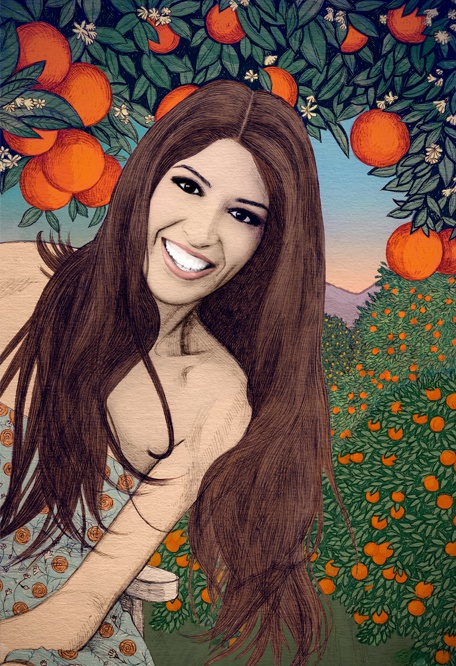Interview with Lavinia Biagiotti Cigna - Illustration by Anna Higgie

Lavinia Biagiotti Cigna has worked alongside her mother since she was in her teens, and now, at the age of 35, is Vice-president of the family group as well as a board member of the Italian National Chamber of Fashion. She is an all-round businesswoman, presenting a popular radio programme and offering fashion tips in her best-selling book “Pronto e Indossato. Ricette di stile per tutte le occasioni” (Ready and Worn: Style ideas for every occasion).
What single garment should a woman ideally have in her wardrobe?
A cashmere pullover: it transcends all seasonal variations, fashion trends or changes in body shape.
In 1988, your mother was the first fashion designer to present a collection in China. What strategies do you use nowadays to promote Italian-made products in an increasingly global and competitive environment?
The show my mother put on in Beijing in 1988 was really an extraordinary event, of huge cultural and media importance. At that time, the commercial aspect was almost immaterial, because the show had a great historic significance in creating a bridge between the East and the West. Fashion acts as a sort of “Esperanto”, a universal language made up of images which overcome all barriers. With a mixture of elegance, curiosity and tact, Italian fashion was able to enter places which had been previously off-limits, like the Forbidden City and Tiananmen Square. Everything is changing at a dizzying speed, with the new technologies and information media. It’s a completely different way of seeing and engaging with reality, and has radically changed our lives. Those customs which seemed, if not indestructible, at least designed to last, have all been swept away, overtaken by other values and actualities with which often genuinely conflict. Fashion, which essentially looks to the future, is inevitably involved in this hectic pace. I believe there is a clear message emerging from this world of hyperbole, firmly anchored to the gift of our unique identity. It is to identify the essential themes such as the link with art and culture, to promote our “production-line of beauty”, authentic quality and life-style. It is to meet the global challenge, and to be instantly recognised, loved and desired. The Italian brand is aspirational and arouses high emotions. The beauty of Italian design is in its craftsmanship, a combination of talent and dexterity.
When Laura Biagiotti created the famous Dolls range, she was considering the shape of real women, far removed from the prototypical top model. Is this a message that you share?
I think we are very privileged to be women working with women! We experiment and innovate, but we never lose sight of the relationship which we have to create between our bodies and what we wear. I believe that a woman’s clothes should be regarded as her main ally: a friend with which to share her daily concerns and ambitions, her positive experiences but also her worries. So they should not represent a further complication in life. They should wrap around her, and give her support and encouragement. In this context, I hate the term “fashion victim”: fashion should love us, not turn us into slaves.
How do you view the phenomenon of street fashion photography?
The street is the most important catwalk in our modern world. There’s an on-going relationship of osmosis and contrast between fashion and the street, and they constantly reflect, influence or follow each other. The street absorbs and reworks the ideas of fashion-designers, and they in their turn assimilate and interpret the suggestions coming from the street. We find this in the outrageous flappers of the 1920s: was it them who inspired Coco Chanel or vice versa? And then there are the hippies, punk and grunge: who influenced who here? Nowadays, we are witnessing a deeper relationship between fashion and the street, connected to the web and to social media: a combination which has magnified both vices and virtues. Famous personalities and ordinary people vie with each other in search of the “look”, to achieve that coveted “post” on an important page. So it amuses me to observe, away from the catwalk, the sober-looking VIPs with their glasses and overcoats, who are almost completely ignored; the successful young bloggers surrounded by flash photographers while battling with the rain and snow in summer outfits and cool sandals, and the wannabes who combine crazy fast fashion items with their auntie’s shirt or a necklace from a street market. This phenomenon interests me because it helps spread a desire for fashion, but it should also be seen in the right proportion, distinguishing the professionals, the amateurs, and the dilettantes who are just throwing themselves into the fray.
What would you like to see in the future of fashion, and in Italian fashion?
I would like to see increasingly Italian-style fashion! Our French colleagues raised the banner for “Faire France”, with a powerful, succinct and successful message. Over the last decade, Italy has lost out on some opportunities, especially in promoting young fashion. But it has also learnt how to react with a new sense of pride, re-establishing its leadership with an amazing, integrated system which combines creativity and industry, craftsmanship and technology. We are living in an “on demand” era: a sort of evolution of the “tailor-made” system used in my Grandmother Delia’s workshop in the 1960s. Italian fashion has to continue to satisfy the primary need for beauty, and it must be able to constantly invent new themes. What is lacking in our country, especially from the political standpoint, is a vision of fashion as a primary asset: a significant part of our exports, a source of income for tens of thousands of workers, a complex production chain, and an ambassador for beauty. It is our equivalent of oil reserves, but a constantly renewable source of energy: renewed every six months, and in a quite extraordinary way.